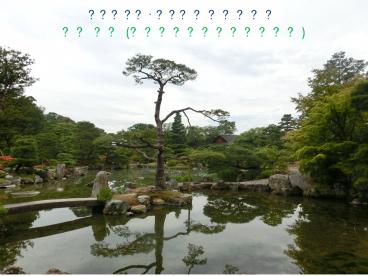????? - PowerPoint PPT Presentation
1 / 37
Title: ?????
1
???????????????? ?? (????????????)
2
Excitation energy
decay threshold to clusters
Cluster-shell competition
Shell structure single-particle motion of
protons and neutrons
Nuclear structure
3
3 alpha model for 12C
T. Yoshida, N. Itagaki, and T. Otsuka, Phys. Rev.
C 79 034308 (2009).
4
a-cluster model
We assume each 4He as (0s)4 configuration with
respect to some localized position Non-central
interactions do not contribute
5
In the low-lying state..
Spin-orbit interaction is the driving force
6
Cluster model covers the model space of the
shell model?
y
x
y
x
This is (s)4(px)4(py)4, but not (s1/2)4(p3/2)8
7
(No Transcript)
8
How we can include jj-coupling shell model-like
correlations in the cluster model?
- If we treat all the Gaussian centers parameters
of the nucleons independently and superpose
different Slater determinants, this is possible
as in anti-symmetrized molecular dynamics (AMD)
and Fermionic molecular dynamics (FMD)
9
(No Transcript)
10
- How we can describe cluster-shell competition in
a simple way? - Is there a simple transformation
- from Brinks cluster model wave function
- to the lowest configuration of jj-coupling
shell model - within a single Slater determinant?
We introduce a general and simple model to
describe this transition
11
How we can include the spin-orbit
contribution In the cluster model??
spatial part of the single particle wave function
exp-?( r Ri )2
In the cluster model, 4 nucleons share the same
Ri value in each alpha cluster
The spin-orbit interaction (r x p) s
lt r gt Gaussian center parameter Ri
lt p gt imaginary part of Ri
For the nucleons in the quasi cluster Ri ?
Rii ? (e_spin x Ri)
Simplified method to include the spin-orbit
contribution (SMSO) N. Itagaki, H. Masui, M.
Ito, and S. Aoyama, Phys. Rev. C 71 064307
(2005).
12
- 12C case
3alpha model ? 0
2alphaquasi cluster ? finite
13
-Y axis
Z axis
X axis
14
Single particle wave function of nucleons in
quasi cluster (spin-up)
Quasi cluster is along x Spin direction is along
z Momentum is along y
the cross term can be Taylor expanded as
15
the single particle wave function in the quasi
cluster becomes
for the spin-up nucleon (complex conjugate for
spin-down)
16
12C
Various configurations of 3as with ?0
17
12C
? ? 0
Various configurations of 3as with ?0
18
We must measure the breaking of alpha cluster in
each state
What is the operator related to the a breaking?
one-body spin-orbit operator for the proton part
19
12C
0.03 0.30 0.28 0.64 one body ls
? ? 0
Various configurations of 3as with ?0
20
For C isotopes
- The R and ? values for the 12C core are randomly
generated - The positions of Gaussian center parameters for
the valence neutrons are randomly generated, and
we superpose many different configurations for
the valence neutrons
21
16C
One-body LS 0.44 0.51 1.45 1.39
22
(No Transcript)
23
Breaking all the clusters
Introducing one quasi cluster
Rotating both the spin and spatial parts of the
quasi cluster by 120 degree (rotation does not
change the j value)
Rotating both the spin and spatial parts of the
quasi cluster by 240 degree (rotation does not
change the j value)
24
Single particle energy of spin-up protons
p3/2
Energy MeV
s1/2
?
R 0.01 fm
25
Energy sufaces
0 energy
LS force
Minimum point R 0.9 fm, ? 0.2 - 89.6 MeV
Tadahiro Suhara, Naoyuki Itagaki, Jozsef Cseh,
and Marek Ploszajczak arXiv nucl-th 1302.5833
26
A single state has different features
27
Comparison with ß-? constraint AMD
SMSO AMD
energy - 89.6 MeV - 90.1 MeV
of freedom 2 (R, ?) 6A(32A)
xyz complex
overlap
28
Tensor contribution in C isotopesusing SMSO
(MeV) 11C 12C 13C 14C 16C
With tensor -64.8 -89.3 -93.8 -106.2
-109.2 Without T -65.6 -91.4 -95.5 -106.3
-111.6 ? 0.9 2.1 1.7
0.1 2.4
We can take into account first order-like tensor
contribution, if we break alphas to take into
account the spin-orbit effects
29
How we can incorporate the 2p2h nature of the
tensor contributionin the cluster modelin a
simple way?
Simplified method to include the tensor
contribution in alpha-cluster model N.
Itagaki, H. Masui, M. Ito, S. Aoyama, and K.
Ikeda Phys. Rev. C 73 034310 1-7 (2006).
30
We would like to break the a cluster in a
simplified way
However, the tensor interaction does not work
even if we break ato 3 nucleons 1 nucleon
system
p?
Tensor interaction works between proton spin-up
and neutron spin-up, but this is cancelled by the
spin-sown neutron located at the same position
n?
n?
Necessary to break aas 211 system (2p2p)
31
-33.83 MeV compared to -27.57 MeV of the (0s)4
model
Model 2
p?
Spin (z) direction
p?
n?
n?
Simplified method to include Tensor contribution
(SMT)
32
12C
33
Summary
- Cluster-shell competition and role of spin-orbit
interaction in light nuclei can be studied in a
simplified way - We can transform Brinks wave function to
jj-coupling shell model (jj subclosure states) by
introducing two parameters - The model is rather general and we can apply to
heavier nuclei - Description of particle-hole states is going on
- First-order-like effect of the tensor interaction
can be taken into account if we break the alpha
clusters to taken into account the spin-orbit
contribution - To take into account the 2p2h nature of the
tensor interaction, we need another model, which
is under development
34
THSR wave function
For the study of heavier systems, we must
simplify the THSR wave function
35
Virtual THSR wave functionN.Itagaki., M.
Kimura, M. Ito, C. Kurokawa, and W. von Oertzen,
PRC 75 037303 (2007)
Gaussian center parameters are randomly generated
by the weight function of
36
3a
Solid, dotted, dashed, dash-dotted ? s 2,3,4,5
fm
r.m.s. radius of 12C (fm)
37
s 4 fm
s 3.5 fm
s 3 fm































